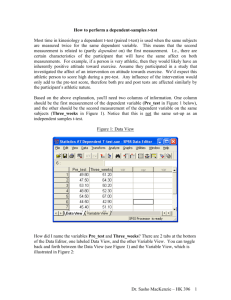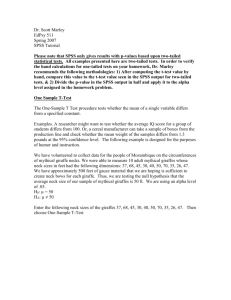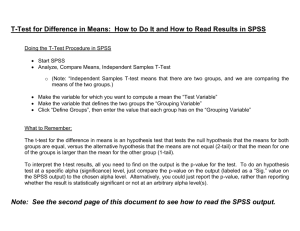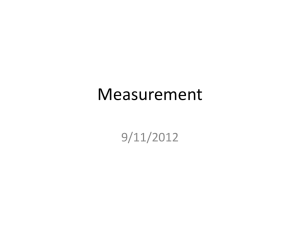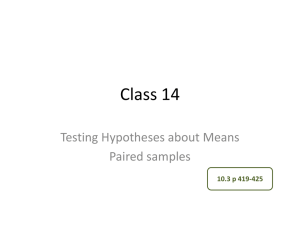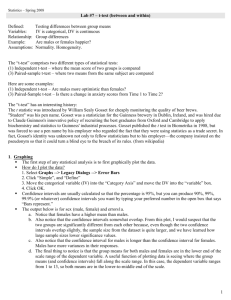The Paired t-Test (A.K.A. Dependent Samples t-Test, or t
advertisement
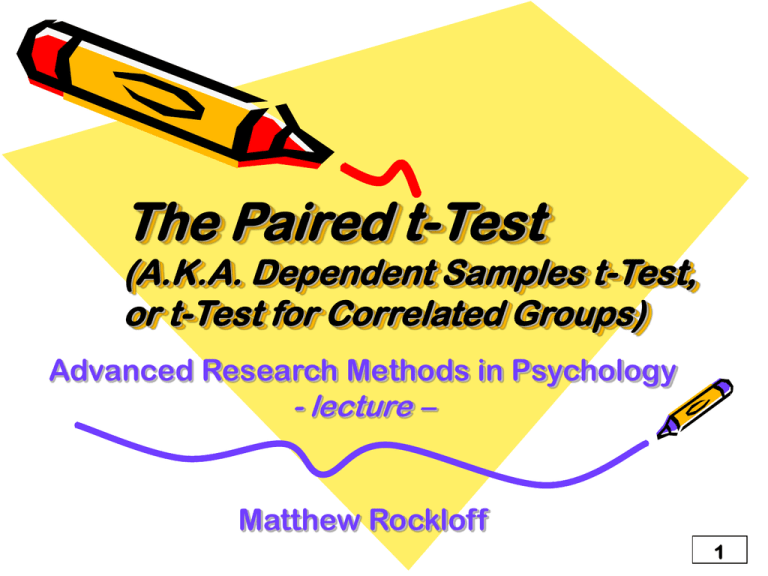
The Paired t-Test (A.K.A. Dependent Samples t-Test, or t-Test for Correlated Groups) Advanced Research Methods in Psychology - lecture – Matthew Rockloff 1 When to use the paired t-test • In many research designs, it is helpful to measure the same people more than once. • A common example is testing for performance improvements (or decrements) over time. • However, in any circumstance where multiple measurements are made on the same person (or “experimental unit”), it may be useful to observe if there are mean differences between these measurements. • The paired t-test will show whether the differences observed in the 2 measures will be found reliably in repeated samples. 2 Example 4.1 • In this example, we will look at the throwing distance for junior varsity javelin toss (in meters). • Five players are selected at random from the entire league. • We are interested in the following research question: • Do players improve on their distance between the pre and post season? • The average throwing distance, in both pre and post season, is recorded in columns 1 and 2 (see next slide) for each of 5 people (P1-P5): 3 Example 4.1 (cont.) Column 1 Column 2 Column 3 Column 4 X1 : X2 : Pre-season Post-season P1: 1 2 1 4 P2: 2 4.5 0 0.25 P3: 2 3 0 1 P4: 2 4.5 0 0.25 P5: 3 6 1 4 1 2 2 4 s x2 2 ( ) n ( 1 1 ) 2 ( 2 2 ) 2 0.4 1.9 4 Example 4.1 (cont.) • Unlike the independent samples t-test, on each row the numbers in columns 2 and 3 come from the same people. • Person 1, for example, threw an average of 1 meter pre-season, but improved to an average of 2 meters in the post-season (after all competition was completed). • It appears that this player may have improved through practice. • How can we find if the league has improved overall from the pre to the post season? 5 Example 4.1 (cont.) • The paired t-test will allow us to see if the improvement that we see in this sample is reliable. • If we selected another 5 players at random from the league, would we still see an improvement? • Without having to go through the trouble and expense of repeated sampling (called replication), we can estimate whether the difference in the 2 means is so large in magnitude that we would likely find the same result if we chose another 5 persons. 6 Example 4.1 (cont.) t 1 2 S S 2rx1x2 S x1 S x2 2 x1 , df = n-1 2 x2 n 1 7 Example 4.1 (cont.) • This paired “t” needs a couple more values that we have not yet computed. • First, we need to find the Standard Deviation of X1 and X2, called Sx1 and Sx2. • These are simply the square-root of the variances ( S x2 0.4 0.6325and S x2 1.9 1.3784 ). 1 2 8 Example 4.1 (cont.) • Second, we need to find the correlation between the pre and post-season distances ( rx x ), or likewise columns 2 and 3. 1 2 • Another section will illustrate how to compute a correlation. • This computation is somewhat long, so we’ll avoid it for now. • I’ll just tell you the correlation is: rx1x2=0.9177. • Any scientific or statistical calculator can get you this answer. 9 Example 4.1 (cont.) t 24 .4 1.9 2(.9177)(.6325)(1.3784) 5 1 -4.78, df = 4 10 Example 4.1 (cont.) • Finally, this computed “t” statistic must be compared with the critical value of the tdistribution. • The critical value of the “t” is the highest magnitude we should expect to find if there is really no difference between the population means of X1 and X2, or in other words, no difference between performance in the pre and post season in the league. • Since we expect there should be improvement in throwing distance, this is a 1-tailed test. 11 Example 4.1 (cont.) • The C.V. t(4), α=.05 = 2.132, therefore we reject the null hypothesis because the absolute value of our “t” at 4.78 is greater than the critical value. • This is a 1-tailed t-test, so we must verify this conclusion by noting that the mean of the post season at 4 meters, is greater than the mean of the pre-season throw average of 2 meters. 12 Example 4.1 (cont.) Our research conclusion states the facts in simple terms: Throwing distances increased significantly from the pre-season (M = 2) to the post-season (M = 4), t(4) = 4.78, p < .05 (one-tailed). 13 Example 4.1 Using SPSS • First, we must setup the variables in SPSS. • Although not strictly necessary, it is good practice to give a unique code to each participant (“personid”). • Unlike the independent samples t-test, the paired t-test has separate entries for 2 dependent variables, rather than an independent and dependent: – DependentVariable1 = preseas (for Pre-season scores) – DependentVariable2 = postseas (for Post-season scores) 14 Example 4.1 Using SPSS (cont.) • In our example, the variables are setup as follows in the SPSS variable view: 15 Example 4.1 Using SPSS (cont.) • It is no longer necessary to provide “codes” (or values) for the independent variable, simply because one does not exist! We can proceed to typing in the data in the SPSS data view: 16 Example 4.1 Using SPSS (cont.) • Notice, this is where the “personid” variables has helped. • If we had incorrectly tried to analyze this problem as an independent samples t-test, then we would have coded for 10 people under “personid.” • Of course, since we have only 5 people in this example, this would have been incorrect. • The personid variable thus allows a simple check for whether we have typed-in the data correctly. • The number of “rows” in SPSS should always equal the number of “subjects” (or likewise, experimental units). 17 Example 4.1 Using SPSS (cont.) • Next, we need the SPSS syntax to run a paired t-test. The code is as follows: t-test pairs = DependentVariable1 DependentVariable2. • In our example, the following code is written: 18 Example 4.1 Using SPSS (cont.) After running the syntax, the following appears in the SPSS output viewer: 19 Example 4.1 Using SPSS (cont.) • You should focus your attention first of the mean values for the pre and the post season performance. • As before, the means (Pre-season=2 and Post-season=4) give us our conclusion. • Namely, we conclude that performance increased from the pre to the post season. • The statistics tell us that our conclusion is true not only for this sample of 5 persons, but also for other samples of 5 persons in the league. 20 Example 4.1 Conclusion • Our test is 1-tailed, so we must divide the 2-tailed probability provided by SPSS in half (p=.009/2 = .0045). • When expressed to 2 significant digits, this value will round to “.00” and as a result the lowest value that can be represented in APA style is “p<.01.” • In short, we can now write our conclusion as follows: Throwing distances increased significantly from the pre-season (M = 2) to the post-season (M = 4), t(4) = 4.78, p < .01 (one-tailed). 21 Thus concludes The Paired t-Test (A.K.A. Dependent Samples t-Test, or t-Test for Correlated Groups) Advanced Research Methods in Psychology - Week 3 lecture – Matthew Rockloff 22

